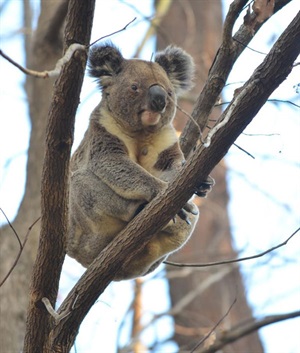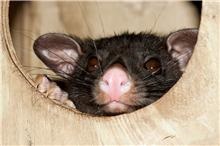Native animals
Flying foxes Birds Possums Snakes Threatened birds Koalas Platypus

Council is working to help our native animals thrive in the Tweed.
All native animals are protected under the NSW National Parks and Wildlife Act.
All enquiries about feeding or interference with wildlife are to be referred to National Parks and Wildlife Service:
Read about the consequences of feeding wildlife:
Listen to our wildlife - bird calls and frog calls recorded at the Australian National Botanic Gardens
Tweed Valley Wildlife Carers
Run by volunteers, Tweed Valley Wildlife Carers help to rescue, rehabilitate and release native animals in the Tweed. They educate residents and encourage regeneration of our unique habitat.
What to do if you find injured wildlife:
Nest boxes
Nest boxes in backyards are a great way to encourage birds to your garden. They also provide possums with an alternative home to your roof.
Nest boxes can provide important habitat for a range of species including birds, arboreal (tree-dwelling) mammals and micro bats. Artificial tree hollows, or ‘nest boxes’ can be used as a replacement for natural hollows.
Identify the hollow-using fauna in your area and use a box with the right sized openings and ‘hollow’.
Flying foxes
 Council has developed the Tweed Flying-fox Camp Management Plan(PDF, 30MB).
Council has developed the Tweed Flying-fox Camp Management Plan(PDF, 30MB).
The plan provides a detailed description of the 16 known active flying-fox camps in the Tweed, and aims to:
- support Council's ability to respond to community concern regarding flying-foxes
- ensure positive conservation outcomes for flying-foxes
- enhance community awareness and understanding
- facilitate camp management approvals and actions where appropriate
The location of Tweed's flying-fox camps can be viewed on Council's Open Data Hub.
Council participates in the National Flying-fox Monitoring Program, carrying out quarterly counts at each camp. If you notice any new camps or changes in activity, please contact Council on 02 6670 2400.
Birds of the Tweed Valley
The Tweed Caldera has an exceptionally high biodiversity, supporting a huge number of plant and animal species. Many bird species found in here are at the northern or southern extents of their range.
Protect yourself from swooping birds
If you consider an aggressive or swooping bird, such as a magpie, to be a serious menace, you can report the incident.
- If the aggressive bird is on public land not owned by Council, such as bushland or private property, report it to the National Parks and Wildlife Service. Contact the Tweed Area Office on 02 6670 8600.
- If the aggressive/swooping bird is on Council-managed land, such as a park or road reserve, report it via our report a problem form.
Minimise the risk of being swooped:
- Know your local swooping hotspots. Keep informed about parks, schoolyards and bike trails in your local area by reading your local newspapers.
- Avoid the area. The best way to protect yourself from a swooping bird, is to avoid venturing into their territory
- Move quickly. If you must pass through the area – move quickly – do not run.
- Cover your head. Wear a hat or carry an umbrella above your head. Cyclists should wear a helmet, dismount and walk through the area.
- Eyes at the back of your head. Birds may be less likely to swoop if they think you are watching them. Draw a pair of ‘eyes’ and attach to the back of hats and helmets.
- Do not harass wildlife. Don’t interfere with or throw stones at birds. This gives them added reason to see humans as a threat and may increase swooping behaviour.
- Do not destroy nests. This may prompt birds to rebuild their nests, prolonging the swooping behaviour.
- Don’t feed swooping birds.
- Travel in a group. If possible, try to travel in a group in areas where there are swooping birds.
- Notify others. Put up warning signs for others who may not be aware that there are swooping birds in the area, or ask Council to do so.
For more information about swooping birds in your area contact National Parks and Wildlife on 02 6670 8600.
Brush turkeys
 Brush turkeys are part of Australia's natural heritage, and many householders now accept these birds as a fascinating part of their backyard environment.
Brush turkeys are part of Australia's natural heritage, and many householders now accept these birds as a fascinating part of their backyard environment.
They are generally shy birds and wary of humans. However, they can become very tame in suburban areas, particularly if they are fed.
Despite some evidence of increasing spread within the suburbs, the long-term survival of the species is seriously threatened by hatchling predation and continued loss of habitat.
It is illegal to trap them, which is the only way to re-locate them. However, re-location is not a solution - when you remove turkeys, others will move in to take their place.
The brush turkey likes moist gardens with intermittent shade, vegetative mulch and available food resources. Keeping this in mind will help you to find ways to deter them.
Keeping Brush turkeys out of your garden
- Do not feed brush turkeys.
- Do not leave food scraps or pet food outside.
How to turkey-proof your garden:
- use heavy coverings such as river rocks, coarse gravel and logs instead of mulch
- protect areas of your garden by surrounding with plants such as Lomandra, low growing Grevillea varieties or plants with prickles
- divert the turkey's attention away from your garden by building a household compost mound or using their favourite scratching material, hay or cane mulch (place in the shade and kept moist)
- use tree guards or fencing to protect young plants.
If a male builds a mound in your yard, he will persist even if you disturb it every day. Mound-building activity will persist during breeding season, and decrease once chicks have left the nest.
If you do not want a nest in your garden try covering the mound with wire or a tarpaulin with heavy weights, but this must be done before any eggs are laid.
Magpies
 Magpies are protected native birds, and a familiar sight in the Tweed.
Magpies are protected native birds, and a familiar sight in the Tweed.
Magpies thrive in suburban areas because parks, playing fields, backyards and schoolyards often provide ideal environments for foraging and breeding.
During the breeding season (typically July to November) magpies may swoop other birds, animals and humans as a warning to intruders that the nest, eggs and juvenile birds will be defended. Swooping behaviour lasts around 6 weeks.
Swooping magpies can be a frightening experience. Take precautions in areas where you know they swoop, or stay away if possible.
Plovers (Masked lapwings)
Commonly known as plovers, they are a medium-sized bird with loud, penetrating calls.
It is a bold bird that swoops at intruders in defence of eggs or young. Some pairs defend large mobile territories around chicks rather than the nest.
Attacks usually cease after eggs hatch and chicks are mobile. Most swooping behaviour is to threaten or bluff to warn off intruders, contact is rarely made.
Possums

Council does not relocate possums. Nor do Tweed Valley Wildlife Carers, unless they are sick or injured, in which case call their 24 hour hotline on 02 6672 4789.
Possums are protected in NSW, it is illegal to harm them in any way, including trapping and relocating them.
Research has shown that nearly 100% of relocated possums die within days of release and sometimes cause the death of other possums.
They fight for their territory, often resulting in injuries followed by a slow and painful death. If they do find a new hollow to live in, re-located possums may displace other wildlife, such as parrots, owls or gliders.
A possum in your roof
The combination of light, smells and an alternative home should encourage the possum to leave your roof.
- Check your roof to make sure it is, in fact, a possum that is living there and not rats. If you hear movement during the day, it is more than likely rats. If you are not sure, you could set a non-lethal trap to check what animals are disturbing you.
- Locate the access points into the roof and identify trees or structures possibly being used to climb up to the roof.
- Place collars made from aluminum or sheet iron around the trunks of trees being used to access the roof and lop any overhanging branches.
- Make or buy a nest box, and install it in your garden as an alternative den site for the possum.
- Spread mothballs in the roof to repel the possum. Do not use rat bait, as this will cause a painful death for possums and possibly other wildlife.
- Place a light in the roof and leave it on for 3 days and nights.
- Once you're sure the possum has left your roof, block off the known entrance points.
Snakes
 If a snake enters your yard, leave it alone and generally it will move on. Know when snake season starts and take precautions:
If a snake enters your yard, leave it alone and generally it will move on. Know when snake season starts and take precautions:
- it is often difficult to correctly identify snakes, so treat all snakes as if they are venomous
- snakes will usually only attack if they feel threatened, give them plenty of room to escape
- clean up aviaries, dog kennels and poultry pens where food attracts mice
- remove debris and clutter from your yard, keep your lawn mowed and slash tall grass along fences
- seal gaps under doorways and any holes or gaps in walls
- don’t try to catch or kill a snake – this is when 90% of snake bites happen.
Relocation of snakes is not recommended unless they are really a threat to your safety. In an event where a snake is a threat, call:
Tweed Valley Wildlife Carers - 24 hour phone - 02 6672 4789 (you will be asked for a donation for snake relocation) or search online for professional snake relocators.